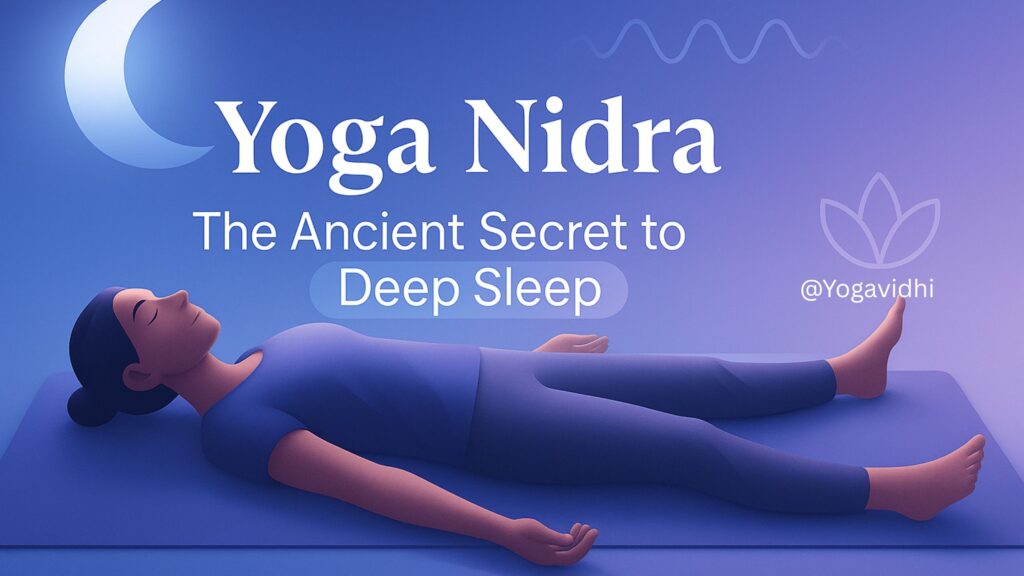In today’s hyper-connected world, restful sleep feels more like a luxury than a daily necessity. Between endless screen time, work stress, and an overactive mind, millions of people struggle to fall asleep or stay asleep. If you’re one of them, there’s a powerful ancient practice that offers a natural, drug-free solution: Yoga Nidra for sleep.
Often called “yogic sleep,” Yoga Nidra is not just another relaxation technique. It’s a scientifically-backed, deeply restorative practice that can help you release mental tension, calm your nervous system, and drift into a peaceful slumber with ease.
Let’s explore how this guided meditative journey can become your nighttime sanctuary.
Yoga Nidra, often referred to as yogic sleep, is a guided meditation practice designed to enhance sleep quality. It guides you into a state of consciousness that lies between wakefulness and sleep. By following a structured meditation, this technique helps to quiet the mind, relax the body, activate the parasympathetic nervous system, and lower stress levels — all of which can contribute to better sleep.
Table of Contents
What is Yoga Nidra?
Yoga Nidra, or “conscious yogic sleep,” is a guided meditation technique that brings you into a state between wakefulness and sleep. You lie comfortably in Shavasana (corpse pose) while being led through a series of verbal instructions—relaxing the body, focusing on the breath, and visualizing calming imagery.
Unlike traditional meditation where you stay alert and seated, Yoga Nidra allows your body and mind to completely let go. You hover in the sweet spot between being awake and asleep, where deep healing and rejuvenation happen.
Unlike regular meditation, you don’t have to try in Yoga Nidra. You just rest, listen, and receive.
The Science Behind Yoga Nidra and Better Sleep
One of the most compelling reasons to use Yoga Nidra for sleep is the science supporting it.
When practiced regularly, Yoga Nidra activates the parasympathetic nervous system—our body’s rest-and-digest mode. This counteracts the fight-or-flight response caused by daily stressors, lowering cortisol levels and inducing a calm state.
Brainwave Shifts
Yoga Nidra guides your brain through various states:
- Beta (alertness)
- Alpha (relaxed focus)
- Theta (dreamy, creative state)
- Delta (deep sleep)
This gradual descent mimics the natural process of falling asleep, making it ideal for those with insomnia, anxiety, or nighttime restlessness.
Evidence-Based Benefits
Studies have shown that Yoga Nidra can:
- Improve sleep quality
- Reduce symptoms of insomnia
- Decrease anxiety and depression
- Enhance mental clarity and focus
- Promote physical and emotional healing
Common Sleep Problems Yoga Nidra Can Help With
If counting sheep, chamomile tea, or white noise apps aren’t helping, Yoga Nidra for sleep may be the missing piece. Here’s how it addresses common sleep challenges:
1. Insomnia
For those who can’t fall asleep or wake up frequently at night, Yoga Nidra reduces the mind’s chatter and guides you gently into stillness.
2. Racing Thoughts
Yoga Nidra quiets overthinking by shifting attention from the mind to the body and breath, creating space between thoughts.
3. Stress and Anxiety
The progressive relaxation used in Yoga Nidra reduces muscular tension and cortisol levels, calming the nervous system.
4. Chronic Fatigue
Unlike naps, which may disrupt your sleep cycle, Yoga Nidra allows you to rest deeply without entering full sleep—replenishing your energy without grogginess.
Read More: Yoga for Stress: Find Inner Peace with Every Breath
Read More: 7 Chakras in Human Body: Unlocking the Energy Within
How to Practice Yoga Nidra for Better Sleep
Getting started is simple—and you don’t need prior yoga experience.
Step-by-Step Guide
- Set the Scene
Find a quiet, dimly lit space. Use a yoga mat, bed, or soft carpet. Lie flat on your back in Shavasana, arms relaxed by your sides. - Use a Guided Audio
You can find free Yoga Nidra recordings on Insight Timer, YouTube, or apps like Calm and Headspace. - Body Scan
The instructor will guide you to mentally scan your body from head to toe, releasing tension along the way. - Breath Awareness
Focus on the natural rhythm of your breath. This anchors you in the present moment. - Set a Sankalpa (Intention)
This is a short, positive affirmation—like “I am calm” or “I sleep peacefully.” The Sankalpa is planted in the subconscious during deep relaxation. - Visualization
You may be guided through soothing imagery, such as walking along a beach or floating in a calm lake. - Return Gently
After 20-40 minutes, you’ll slowly return to a waking state—or drift off into natural sleep.
Best Time and Setup for Practicing Yoga Nidra
When to Practice
- Before Bed: Ideal for easing into sleep
- During the Day: A 20-minute Yoga Nidra nap can be equivalent to 2 hours of deep sleep
Create a Sleep-Friendly Space
- Dim the lights or use a sleep mask
- Use a blanket to stay warm
- Add calming scents like lavender or sandalwood
- Put your phone on “Do Not Disturb”
- Use headphones for immersive audio
Yoga Nidra vs. Other Sleep Techniques
Let’s compare Yoga Nidra for sleep with popular alternatives:
| Technique | Pros | Cons |
| Yoga Nidra | Deep mental and physical relaxation, improves sleep quality, no side effects | Needs guided audio and quiet space |
| Meditation | Builds focus and calm | Can be difficult for beginners |
| Breathing Exercises | Calms the nervous system | Less structured, may not engage the mind fully |
| Sleep Medications | Fast-acting | Risk of dependency, side effects |
| ASMR | Soothing sounds | Doesn’t address underlying stress patterns |
Yoga Nidra stands out as a holistic, accessible, and drug-free approach that improves sleep naturally—no pills or side effects required.
Tips for Beginners
- Don’t worry if you fall asleep. That’s part of the healing.
- Choose a voice you like. The narrator’s tone can make or break the experience.
- Practice daily for the best results—even 10-15 minutes helps.
- Be patient. Like training a muscle, it takes time to master relaxation.
Real People, Real Results
Many people who’ve integrated Yoga Nidra into their sleep routine report profound benefits:
“I’ve struggled with insomnia for years. After just one week of Yoga Nidra, I’m finally sleeping through the night.” — Anita R., Delhi
“My anxiety was keeping me up. Now I listen to a 30-minute Yoga Nidra session, and I fall asleep halfway through.” — Ravi T., Bangalore

Final Thoughts: Why You Should Try Yoga Nidra for Sleep Tonight
If your nights are filled with tossing, turning, and mental noise, Yoga Nidra for sleep offers a sanctuary of silence. It’s simple, soothing, and supported by science. Whether you’re dealing with chronic insomnia or just looking to sleep more deeply, this yogic practice can transform your nights—and your life.
So tonight, instead of scrolling or stressing, turn off the lights, lie back, and let Yoga Nidra guide you home to rest.
FAQs Yoga Nidra for Sleep:
Q. What if I fall asleep during Yoga Nidra?
Ans: That’s completely fine! Yoga Nidra is designed to bring you into a sleep-like state. Even if you sleep, your subconscious continues to absorb its benefits.
Q. How often should I practice Yoga Nidra?
Ans: Daily practice yields the best results, especially before bed. Even 3-4 times a week can significantly improve sleep quality.
Q. Do I need to be flexible or experienced in yoga?
Ans: Not at all! Yoga Nidra involves no physical postures—just lying down and listening.
Q. Can Yoga Nidra replace regular sleep?
Ans: It doesn’t replace full sleep but can enhance its quality and provide deep rest during the day.
Q. What’s the best Yoga Nidra audio for beginners?
Ans: Apps like Insight Timer or YouTube channels like Yoga Nidra Network and Daring to Rest offer excellent free options.
Q. Does yoga nidra help you fall asleep?
Ans: Research indicates that yoga nidra helps lower stress hormones in the body. Since stress is often a major barrier to achieving restful sleep, this practice can be especially beneficial. Studies have also shown that yoga nidra enhances sleep quality, even in individuals suffering from chronic insomnia.
Declaration Note:
We use third-party videos and images on https://yogavidhi.com/ for educational and illustrative purposes. All rights belong to their respective owners. No copyright infringement is intended.



